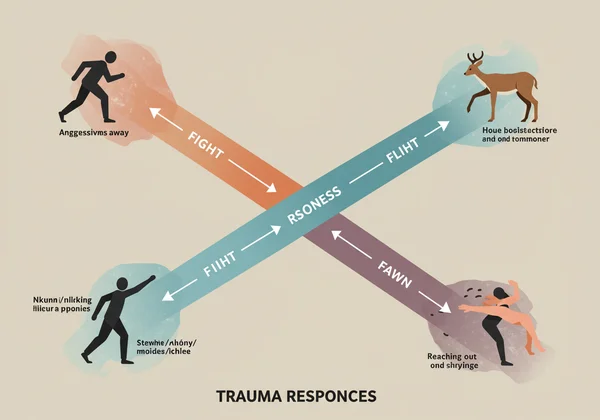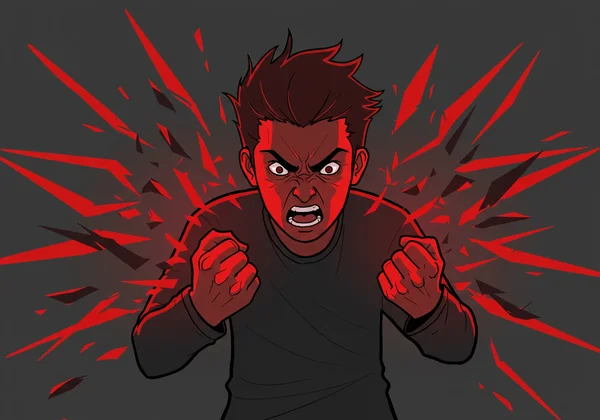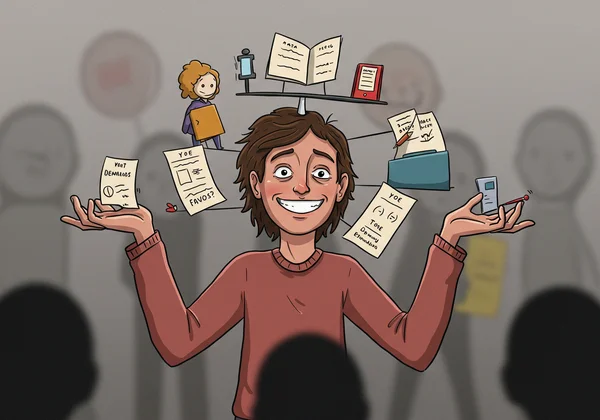CPTSD Fight, Flight, Freeze, Fawn: Understanding Trauma Responses
Have you ever felt overwhelmed by your own reactions, lashing out in anger or shutting down completely without knowing why? For many who have endured long-term trauma, these intense patterns are not character flaws; they are deeply ingrained survival instincts. These are often referred to as the CPTSD fight, flight, freeze, and fawn responses. Understanding them is the first step toward validation and healing. But how can I tell if I have CPTSD? Together, we'll explore these automatic reactions, helping you see your experiences in a new light and discover a path toward feeling more in control.
These responses can be confusing and isolating, but you are not alone in this experience. Gaining clarity on how they manifest in your life is a powerful move toward self-awareness. To get a clearer picture of your own patterns, consider taking a free CPTSD test for confidential, personalized insights.
What Are the Four F's of CPTSD?
The "Four F's" describe the primary ways our nervous system automatically responds when it perceives a threat. For individuals with Complex PTSD, which often stems from prolonged or repeated trauma (like childhood neglect or long-term abuse), the "threat" switch can get stuck in the "on" position. This makes these survival responses show up in everyday situations, long after the original danger has passed. They are not conscious choices but reflexive actions designed to keep you safe.

The Roots of These Trauma Responses
Our brains are wired for survival. When faced with danger, the amygdala (the brain's alarm system) triggers a cascade of hormones like adrenaline and cortisol. This prepares the body to react instantly. In a healthy nervous system, this response deactivates once the threat is gone. However, chronic trauma can dysregulate this system, leading to these four F responses becoming default behaviors in relationships, work, and daily life. Understanding these survival responses is crucial for offering yourself compassion.
The Fight Response in CPTSD: When Anger Becomes a Shield
The fight response is about confronting a perceived threat head-on. In a survival situation, this means physically fighting off an attacker. In the context of CPTSD, this response often manifests as aggression, anger, irritability, or a need for control. It becomes a shield to keep others at a distance and prevent vulnerability, which the nervous system has learned is dangerous.
Recognizing Fight Mode Manifestations
Someone in fight mode might seem demanding, controlling, or argumentative. They may have a short temper, engage in verbal altercations, or feel a constant need to be "right." This isn't about being a difficult person; it's a deep-seated way your system tried to protect a part of you that felt incredibly fragile and threatened. This response can be directed outward at others or inward as a harsh inner critic.
What Does a CPTSD Outburst Look Like?
A CPTSD outburst often appears as a sudden, intense, and seemingly disproportionate emotional reaction to a trigger. It can look like explosive anger, screaming, or throwing things. For the person experiencing it, it feels like a complete loss of control, as if the past danger is happening right now. Afterward, they may feel deep shame and confusion, further reinforcing negative self-beliefs.

The Flight Response: Escaping the Unbearable
The flight response is the instinct to escape from danger. While this can mean physically running away, for those with CPTSD, it often takes more subtle forms. Flight is about creating distance from emotional pain and triggers through constant activity or distraction. It is a way of outrunning feelings that seem too overwhelming to face.
How Flight Appears in Daily Life (Beyond Physical Escape)
In everyday life, the flight response can look like workaholism, obsessive hobbies, substance use, or an inability to sit still. It might be a constant need to be busy, a fear of quiet moments, or difficulty with commitment in relationships. These behaviors serve the same purpose: to avoid the internal discomfort associated with the trauma. If you find yourself constantly moving to avoid your feelings, you might be in a flight pattern. You can explore your responses in a safe environment.
The Urge to Flee: Restlessness and Avoidance
This response creates a chronic sense of restlessness and an internal pressure to keep moving. The thought of being still or alone with one's thoughts can feel terrifying. This can also manifest as social avoidance, where a person frequently cancels plans or ends relationships abruptly when things get too emotionally intimate.
The Freeze Response: When Your Body Gets "Stuck"
The freeze response is what happens when fighting or fleeing aren't viable options. The nervous system essentially hits the brakes, leading to a state of shutdown. This response is often misunderstood, appearing as passivity or disinterest, but it is an intense state of high alert where the body is immobilized.
Understanding "What is a Freeze in CPTSD?"
To understand what is a freeze in CPTSD, imagine a deer in the headlights. The body becomes still, but the mind is often racing. It can feel like being trapped inside your own body, unable to move or speak. This response can manifest as procrastination, difficulty making decisions, or feeling "stuck" in life. It's a profound sense of powerlessness that reflects the helplessness felt during the original trauma.
Dissociation, Numbness, and the Shutdown Experience
The primary tools of the freeze response are dissociation and emotional numbness. Dissociation is a feeling of being disconnected from your thoughts, feelings, body, or the world around you. You might feel like you're watching your life from a distance. This "shutdown" is the mind's way of protecting you from overwhelming emotional or physical pain.

The Fawn Response: Appeasing to Survive
The fawn response, a term popularized by therapist Pete Walker, is unique to complex trauma. It involves trying to appease a threat by becoming helpful, agreeable, and compliant. A child who learns that their safety depends on keeping an unpredictable caregiver happy may develop this into a lifelong pattern.
People-Pleasing as a Trauma Response
The fawn response CPTSD pattern is often mistaken for simple kindness or being a "people-pleaser." However, its roots are in survival. A person in a fawn response will often abandon their own needs, feelings, and boundaries to cater to others. They believe that if they can just be "good enough" or "helpful enough," they will be safe from conflict, rejection, or anger.
The Cost of Constant Accommodation and Self-Abandonment
The long-term cost of this response is severe. It leads to a loss of identity, chronic resentment, and an inability to recognize one's own needs. This pattern of self-abandonment makes individuals vulnerable to unhealthy or exploitative relationships, as their "fawning" can be mistaken for an invitation to be taken advantage of. Recognizing this pattern is a critical step toward reclaiming your sense of self.

Recognizing and Navigating CPTSD Triggers
A trigger is any sensory or emotional cue that the brain associates with past trauma, activating one of the Four F's. It pulls you out of the present and into the past, causing an intense emotional reaction.
What is a CPTSD Trigger Like?
What is a CPTSD trigger like? It can be anything—a certain tone of voice, a particular smell, a specific time of day, or even an internal feeling like loneliness. The reaction is often automatic and overwhelming. You might not even consciously connect the trigger to the trauma, only noticing the sudden surge of anger (fight), anxiety (flight), numbness (freeze), or the urge to please (fawn).
Identifying Your Personal Triggers and Early Warning Signs
Learning to identify your personal triggers is a key part of healing. This involves paying gentle attention to your body and emotions. Notice when you feel a sudden shift in your mood or physical state. What was happening right before? Keeping a simple journal can help you identify patterns and the early warning signs of a trauma response, giving you a chance to use coping strategies before you become overwhelmed.
Practical Strategies for Managing the Four F's
While professional therapy is the most effective path for healing CPTSD, there are strategies you can use to manage these responses in the moment. The goal is not to eliminate them but to increase your ability to choose your response rather than being run by it.
Grounding Techniques for Overwhelm
When you feel a trauma response activating, grounding techniques can help bring you back to the present moment. Try the 5-4-3-2-1 method: name five things you can see, four things you can feel, three things you can hear, two things you can smell, and one thing you can taste. This pulls your attention away from the internal storm and back to the safety of your current environment.
Building Self-Regulation Skills and Inner Safety
Long-term healing involves building self-regulation skills. This includes practicing mindfulness, learning to identify and name your emotions, and developing self-compassion. The goal is to create a sense of inner safety, reassuring the traumatized parts of you that you are safe now. Each time you successfully navigate a trigger without being overwhelmed, you are rewriting old neural pathways.

Disclaimer: This article is for informational purposes only and is not a substitute for professional medical advice, diagnosis, or treatment. The information provided, including the self-assessment tool, is intended for preliminary self-screening and educational use. Please consult with a qualified mental health professional or medical doctor for any health concerns.
Understanding Your Trauma Responses: A Step Towards Healing
Recognizing fight, flight, freeze, and fawn as adaptive survival responses—not personal failings—is a profoundly validating and empowering act. It allows you to approach yourself with compassion instead of criticism. It is the first step on a journey toward understanding your past and reclaiming your present.
If this article resonates with you, it may be helpful to explore these patterns more deeply. The free and confidential online test, based on the WHO's International Trauma Questionnaire (ITQ), can provide you with personalized insights into how these symptoms may be affecting you. Taking this step can provide the clarity and validation you need to move forward on your healing journey.
Common Questions
How can I tell if I have CPTSD?
While this article describes common symptoms, the only way to get a formal diagnosis is through a qualified mental health professional. However, a reliable screening tool can be a valuable first step. A good cptsd symptoms test can help you organize your experiences and validate your feelings, providing a solid starting point for a conversation with a therapist. Our free self-assessment is designed for this purpose.
What everyday struggles do people with CPTSD face?
Everyday struggles can be vast and varied. They often include difficulty trusting others, maintaining healthy relationships, and regulating emotions. People may struggle with a persistent sense of worthlessness or shame, chronic physical ailments like fatigue or pain, and feeling disconnected from themselves and the world. Simple tasks can feel overwhelming when your nervous system is constantly on high alert.
Do people with CPTSD cry often?
This varies greatly. Some individuals with CPTSD may cry frequently, as their emotional regulation is impaired and they feel overwhelmed by sadness or grief. For others, particularly those who rely on the "freeze" response, crying can be nearly impossible. They may feel emotionally numb and disconnected from their feelings of sadness, even when they know it's there. Both experiences are valid responses to trauma.